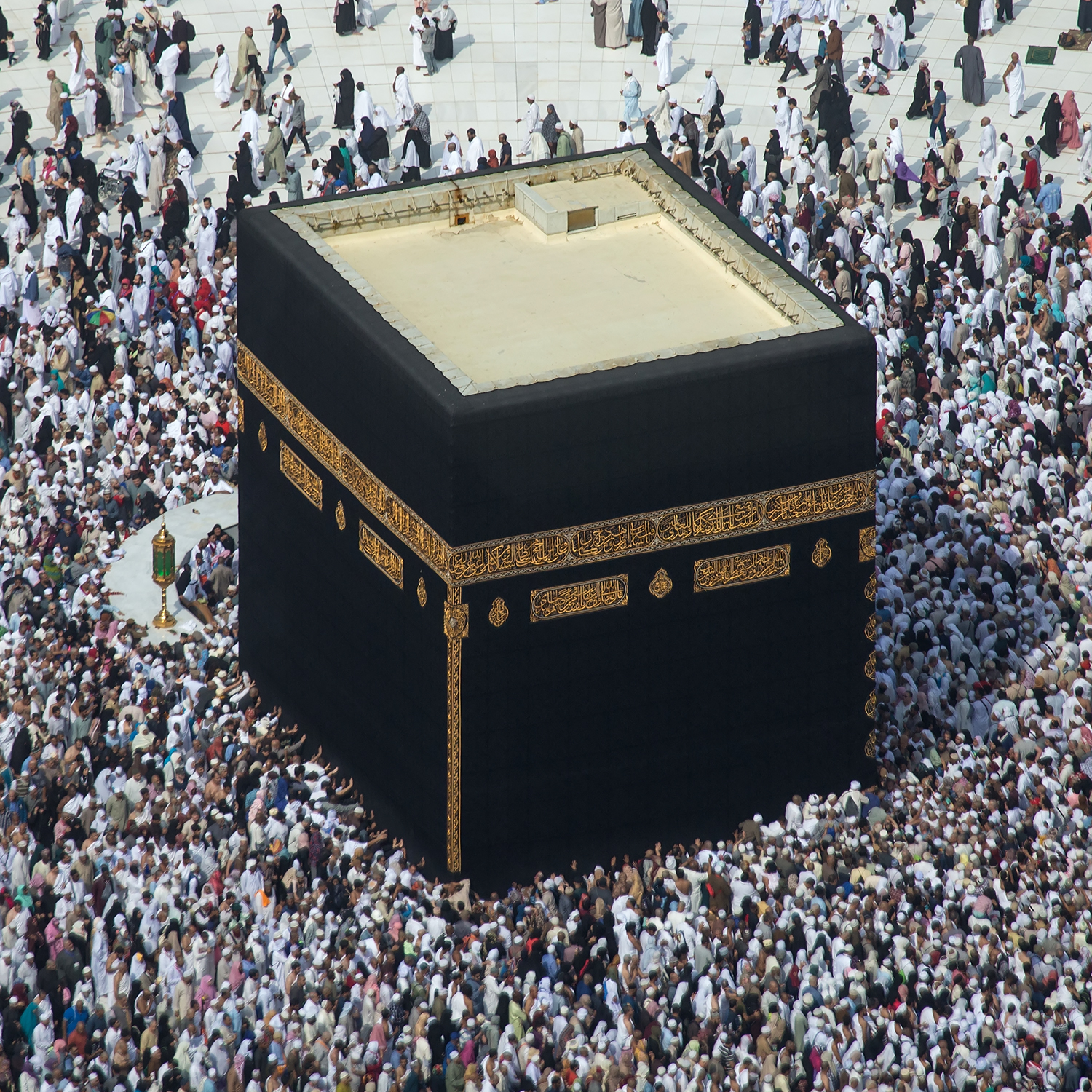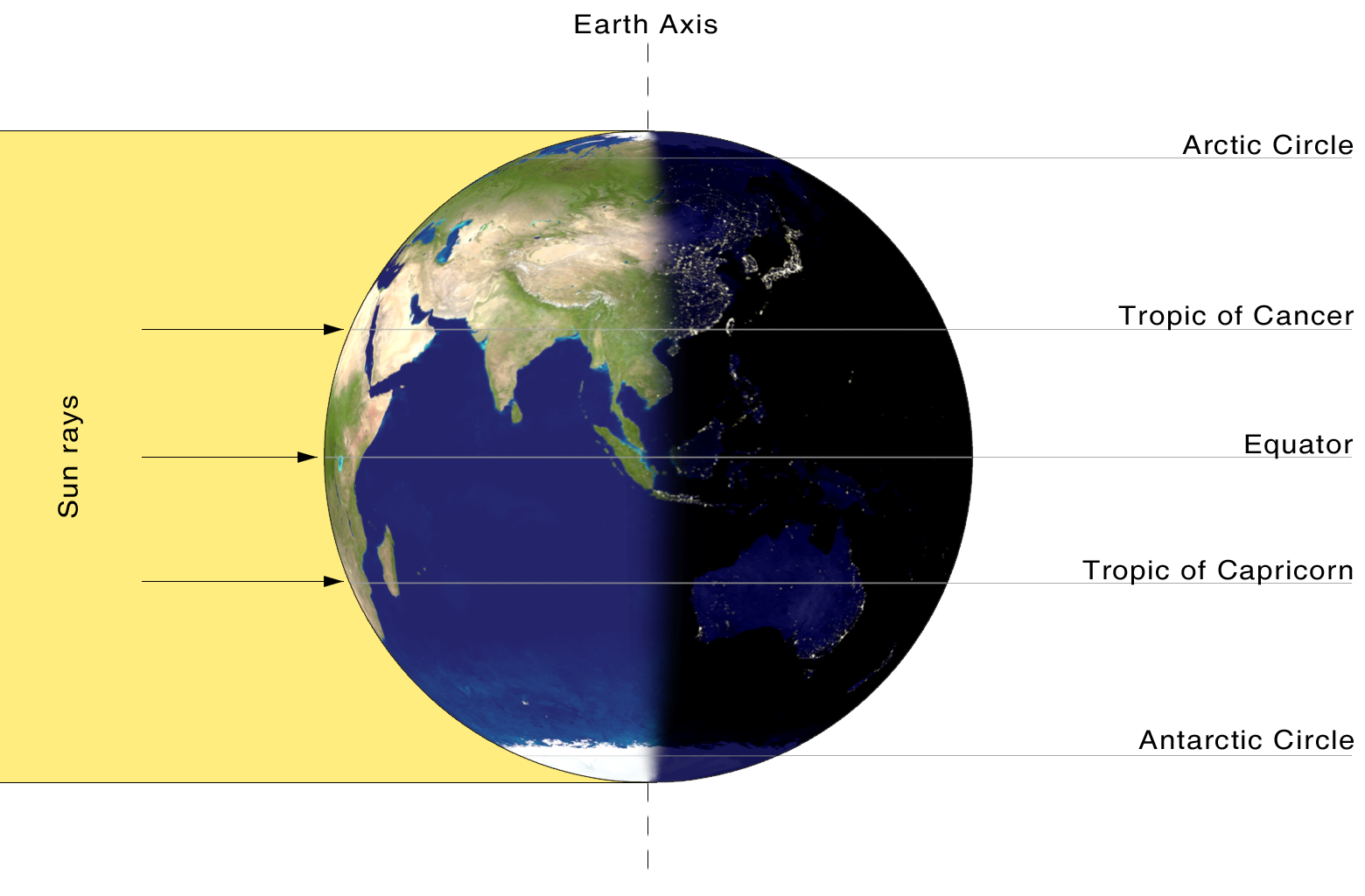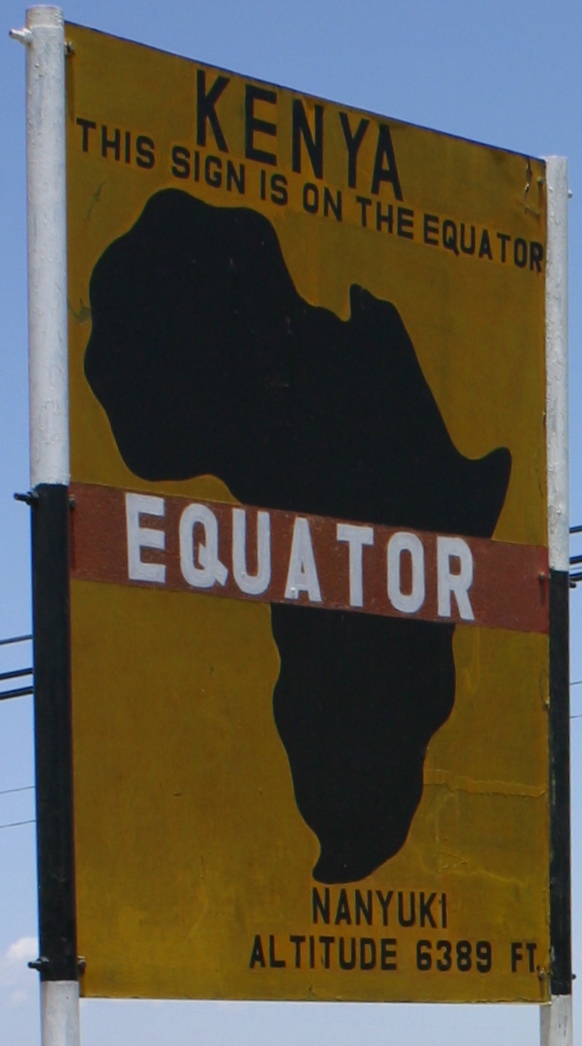|
Subsolar Point
The subsolar point on a planet is the point at which its sun is perceived to be directly overhead (at the zenith); that is, where the sun's rays strike the planet exactly perpendicular to its surface. It can also mean the point closest to the sun on an astronomical object, even though the sun might not be visible. To an observer on a planet with an orientation and rotation similar to those of Earth, the subsolar point will appear to move westward, completing one circuit around the globe each day, approximately moving along the equator. However, it will also move north and south between the tropics over the course of a year, so it is spiraling like a helix A helix () is a shape like a corkscrew or spiral staircase. It is a type of smooth space curve with tangent lines at a constant angle to a fixed axis. Helices are important in biology, as the DNA molecule is formed as two intertwined hel .... The subsolar point contacts the Tropic of Cancer on the June so ... [...More Info...] [...Related Items...] OR: [Wikipedia] [Google] [Baidu] |
Lahaina Noon
Lāhainā Noon is a semi-annual tropical solar phenomenon when the Sun culminates at the zenith at solar noon, passing directly overhead (above the subsolar point). The term ''Lāhainā Noon'' was coined by the Bishop Museum in Hawai'i. Details The subsolar point travels through the tropics. Hawaii is the only US state in the tropics and thus the only one to experience Lāhainā Noon. In 2022, the phenomenon occurred in Honolulu on May 26 and July 16. Hawaii and other locations between the Tropic of Cancer and Tropic of Capricorn receive the sun's direct rays as the apparent path of the sun passes overhead before and after the summer solstice. The Lāhainā Noon can occur anywhere from 12:16 to 12:43 p.m. Hawaii–Aleutian Standard Time. At that moment objects that stand straight up (flagpoles, bollards, telephone poles, etc.) cast no outward shadow. The most southerly points in Hawaii experience Lāhainā Noon on earlier and later dates than the northern parts. For exa ... [...More Info...] [...Related Items...] OR: [Wikipedia] [Google] [Baidu] |
Qibla Observation By Shadows
Twice every year, the Sun culminates at the zenith of the ''Kaaba'' in Mecca, the holiest site in Islam, at local solar noon, allowing the qibla (the direction towards the ''Kaaba'') to be ascertained in other parts of the world by observing the shadows cast by vertical objects. This phenomenon occurs at 12:18 Saudi Arabia Standard Time (SAST; 09:18 UTC) on 27 or 28 May (depending on the year), and at 12:27 SAST (09:27 UTC) on 15 or 16 July (depending on the year). At these times, the sun appears in the direction of Mecca, and shadows cast by vertical objects determine the qibla. At two other moments in the year, the sun passes through the nadir (the antipodal zenith) of the ''Kaaba'', casting shadows that point in the opposite direction, and thus also determine the qibla. These occur on 12, 13, or 14 January at 00:30 SAST (21:30 UTC on the preceding day), and 28 or 29 November at 00:09 SAST (21:09 UTC on the preceding day). The shadow points towards Mecca because the sun path ... [...More Info...] [...Related Items...] OR: [Wikipedia] [Google] [Baidu] |
June Solstice
The June solstice is the solstice on Earth that occurs annually between 20 and 22 June according to the Gregorian calendar The Gregorian calendar is the calendar used in most parts of the world. It was introduced in October 1582 by Pope Gregory XIII as a modification of, and replacement for, the Julian calendar. The principal change was to space leap years di .... In the Northern Hemisphere, the June solstice is the summer solstice (the day with the longest period of daylight), while in the Southern Hemisphere it is the winter solstice (the day with the shortest period of daylight). It is also known as the northern solstice. Solar year The June solstice solar year is the solar year based on the June solstice. It is thus the length of time between adjacent June solstices. The length of the day on June solstice See also Astronomy * March equinox * September equinox * December solstice Holidays * Holi * Inti Raymi * Kupala Night * Midnight sun * Midsumme ... [...More Info...] [...Related Items...] OR: [Wikipedia] [Google] [Baidu] |
Honolulu Star-Bulletin
The ''Honolulu Star-Bulletin'' was a daily newspaper based in Honolulu, Hawaii, Honolulu, Hawaii, United States. At the time publication ceased on June 6, 2010, it was the second largest daily newspaper in the state of Hawaii (after the ''Honolulu Advertiser''). The ''Honolulu Star-Bulletin'', along with a sister publication called ''MidWeek'', was owned by Black Press of Victoria, British Columbia, Canada and administered by a council of local Hawaii investors. The daily merged with the ''Advertiser'' on June 7, 2010, to form the ''Honolulu Star-Advertiser'', after Black Press's attempts to find a buyer fell through. History Farrington Era The ''Honolulu Star-Bulletin'' traces its roots to the Feb. 1, 1882, founding of the ''Evening Bulletin'' by J. W. Robertson and Company. In 1912, it merged with the ''Hawaiian Star'' to become the ''Honolulu Star-Bulletin''. Wallace Rider Farrington, who later became territorial governor of Hawaii, was the editor of the newspaper from 1898 ... [...More Info...] [...Related Items...] OR: [Wikipedia] [Google] [Baidu] |
United States
The United States of America (U.S.A. or USA), commonly known as the United States (U.S. or US) or America, is a country primarily located in North America. It consists of 50 U.S. state, states, a Washington, D.C., federal district, five major unincorporated territories, nine United States Minor Outlying Islands, Minor Outlying Islands, and 326 Indian reservations. The United States is also in Compact of Free Association, free association with three Oceania, Pacific Island Sovereign state, sovereign states: the Federated States of Micronesia, the Marshall Islands, and the Palau, Republic of Palau. It is the world's List of countries and dependencies by area, third-largest country by both land and total area. It shares land borders Canada–United States border, with Canada to its north and Mexico–United States border, with Mexico to its south and has maritime borders with the Bahamas, Cuba, Russia, and other nations. With a population of over 333 million, it is the List of ... [...More Info...] [...Related Items...] OR: [Wikipedia] [Google] [Baidu] |
Hawaii
Hawaii ( ; haw, Hawaii or ) is a state in the Western United States, located in the Pacific Ocean about from the U.S. mainland. It is the only U.S. state outside North America, the only state that is an archipelago, and the only state geographically located within the tropics. Hawaii comprises nearly the entire Hawaiian archipelago, 137 volcanic islands spanning that are physiographically and ethnologically part of the Polynesian subregion of Oceania. The state's ocean coastline is consequently the fourth-longest in the U.S., at about . The eight main islands, from northwest to southeast, are Niihau, Kauai, Oahu, Molokai, Lānai, Kahoolawe, Maui, and Hawaii—the last of these, after which the state is named, is often called the "Big Island" or "Hawaii Island" to avoid confusion with the state or archipelago. The uninhabited Northwestern Hawaiian Islands make up most of the Papahānaumokuākea Marine National Monument, the United States' largest prot ... [...More Info...] [...Related Items...] OR: [Wikipedia] [Google] [Baidu] |
Equation Of Time
In mathematics, an equation is a formula that expresses the equality of two expressions, by connecting them with the equals sign . The word ''equation'' and its cognates in other languages may have subtly different meanings; for example, in French an ''équation'' is defined as containing one or more variables, while in English, any well-formed formula consisting of two expressions related with an equals sign is an equation. ''Solving'' an equation containing variables consists of determining which values of the variables make the equality true. The variables for which the equation has to be solved are also called unknowns, and the values of the unknowns that satisfy the equality are called solutions of the equation. There are two kinds of equations: identities and conditional equations. An identity is true for all values of the variables. A conditional equation is only true for particular values of the variables. An equation is written as two expressions, connected b ... [...More Info...] [...Related Items...] OR: [Wikipedia] [Google] [Baidu] |
Declination Of The Sun
The position of the Sun in the sky is a function of both the time and the geographic location of observation on Earth's surface. As Earth orbits the Sun over the course of a year, the Sun appears to move with respect to the fixed stars on the celestial sphere, along a circular path called the ecliptic. Earth's rotation about its axis causes diurnal motion, so that the Sun appears to move across the sky in a Sun path that depends on the observer's geographic latitude. The time when the Sun transits the observer's meridian depends on the geographic longitude. To find the Sun's position for a given location at a given time, one may therefore proceed in three steps as follows: # calculate the Sun's position in the ecliptic coordinate system, # convert to the equatorial coordinate system, and # convert to the horizontal coordinate system, for the observer's local time and location. This is the coordinate system normally used to calculate the position of the Sun in terms of solar ... [...More Info...] [...Related Items...] OR: [Wikipedia] [Google] [Baidu] |
September Equinox
The September equinox (or southward equinox) is the moment when the Sun appears to cross the celestial equator, heading southward. Because of differences between the calendar year and the tropical year, the September equinox may occur anytime from September 21 to 24. At the equinox, the Sun as viewed from the equator sunrise, rises due east and sunset, sets due west. Before the Southward equinox, the Sun rises and sets more northerly, and afterwards, it rises and sets more southerly. The equinox may be taken to mark the end of Astronomical season, astronomical summer and the beginning of astronomical autumn (autumnal equinox) in the Northern Hemisphere, while marking the end of astronomical winter and the start of astronomical spring (vernal equinox) in the Southern Hemisphere. Occurrences The September equinox is one point in time commonly used to determine the length of the tropical year. The dates and times of the September equinoxes that occur from the year 2017 to 202 ... [...More Info...] [...Related Items...] OR: [Wikipedia] [Google] [Baidu] |
March Equinox
The March equinox or northward equinox is the equinox on the Earth when the subsolar point appears to leave the Southern Hemisphere and cross the celestial equator, heading northward as seen from Earth. The March equinox is known as the vernal equinox (spring equinox) in the Northern Hemisphere and as the autumnal equinox in the Southern Hemisphere. On the Gregorian calendar, the northward equinox can occur as early as 19 March or as late as 21 March at 0° longitude. For a common year the computed time slippage is about 5 hours 49 minutes ''later'' than the previous year, and for a leap year about 18 hours 11 minutes ''earlier'' than the previous year. Balancing the increases of the common years against the losses of the leap years keeps the calendar date of the March equinox from drifting more than one day from 20 March each year. The March equinox may be taken to mark the beginning of astronomical spring and the end of astronomical winter in the Northern Hemisphere ... [...More Info...] [...Related Items...] OR: [Wikipedia] [Google] [Baidu] |
Equator
The equator is a circle of latitude, about in circumference, that divides Earth into the Northern and Southern hemispheres. It is an imaginary line located at 0 degrees latitude, halfway between the North and South poles. The term can also be used for any other celestial body that is roughly spherical. In spatial (3D) geometry, as applied in astronomy, the equator of a rotating spheroid (such as a planet) is the parallel (circle of latitude) at which latitude is defined to be 0°. It is an imaginary line on the spheroid, equidistant from its poles, dividing it into northern and southern hemispheres. In other words, it is the intersection of the spheroid with the plane perpendicular to its axis of rotation and midway between its geographical poles. On and near the equator (on Earth), noontime sunlight appears almost directly overhead (no more than about 23° from the zenith) every day, year-round. Consequently, the equator has a rather stable daytime temperature ... [...More Info...] [...Related Items...] OR: [Wikipedia] [Google] [Baidu] |

.jpg)




%2C_Phang_Nga_Bay%2C_Thailand.jpg)


